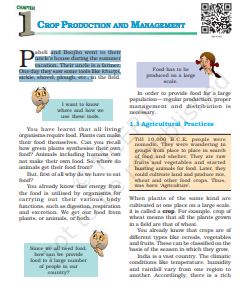‘NCERT Solutions for Class 8 Science Chapter 1‘ PDF Quick download link is given at the bottom of this article. You can see the PDF demo, size of the PDF, page numbers, and direct download Free PDF of ‘Ncert Class 8 Science Chapter 1 Exercise Solution’ using the download button.
NCERT Class 8 Science Textbook Chapter 1 With Answer PDF Free Download

Chapter 1: Crop Production and Management
1.1 Agricultural Practices
When plants of the same kind are cultivated in one place on a large scale, it is called a crop. For example, a crop of wheat means that all the plants grown in a field are that of wheat.
You already know that crops are of different types like cereals, vegetables, and fruits. These can be classified on the basis of the season in which they grow.
India is a vast country. The climatic conditions like temperature, humidity, and rainfall vary from one region to another.
Accordingly, there is a rich variety of crops grown in different parts of the country. Despite this diversity, two broad cropping patterns can be identified.
These are:
(i) Kharif Crops: The crops which are sown in the rainy season are called Kharif crops. The rainy season in India is generally from June to September. Paddy, maize, soya bean, groundnut, and cotton are Kharif crops.
(ii) Rabi Crops: The crops grown in the winter season (October to March) are called rabi crops. Examples of rabi crops are wheat, gram, pea, mustard, and linseed. Besides these, pulses and vegetables are grown during summer in many places.
1.2 Basic Practices of Crop Production
Cultivation of crops involves several activities undertaken by farmers over a period of time.
You may find that these activities are similar to those carried out by a gardener or even by you when you grow ornamental plants in your house.
These activities or tasks are referred to as agricultural practices which are listed below:
(i) Preparation of soil
(ii) Sowing
(iii) Adding manure and fertilizers
(iv) Irrigation
(v) Protecting from weeds
(vi) Harvesting
(vii) Storage
1.3 Preparation of Soil
The preparation of the soil is the first step before growing a crop. One of the most important tasks in agriculture is to turn the soil and loosen it.
This allows the roots to penetrate deep into the soil. The loose soil allows the roots to breathe easily even when they go deep into the soil. Why does the loosening of soil allow the roots to breathe easily?
The loosened soil helps in the growth of earthworms and microbes present in the soil.
These organisms are friends of the farmer since they further turn and loosen the soil and add humus to it. But why the soil needs to be turned and loosened?
You have learned in the previous classes that soil contains minerals, water, air, and some living organisms.
In addition, dead plants and animals get decomposed by soil organisms. In this way, various nutrients in the dead organisms are released back into the soil. These nutrients are again absorbed by plants.
| Author | NCERT |
| Language | English |
| No. of Pages | 16 |
| PDF Size | 2.4 MB |
| Category | Science |
| Source/Credits | ncert.nic.in |
NCERT Solutions Class 8 Science Chapter 1 Crop Production and Management
1. What is irrigation? Describe two methods of irrigation that conserve water.
Soln:
The supply of water to crops at regular intervals is called irrigation. Methods of irrigation that conserve water are
a) Drip Irrigation: Here the water goes drop by drop directly into the roots this method is very useful as it conserves the water and also helps in avoiding weeds.
b) Sprinkler system: This method is in use in mainly uneven land where sufficient water is not available. The perpendicular pipes, having rotating nozzles on top, are joined to the main pipeline at regular intervals.
When water is allowed to flow through the main pipe under pressure with the help of a pump, it escapes from the rotating nozzles. It gets sprinkled on the crop as if it is raining.
2. If wheat is sown in the Kharif season, what would happen? Discuss.
Soln:
Wheat crops may get destroyed if sown in the Kharif season because of unfavorable temperatures, pests, and adaptable conditions for the plants to grow.
Kharif comes during the rainy season, hence it is not a wise idea to grow wheat during Kharif season.
3. Explain how soil gets affected by the continuous plantation of crops in a field.
Soln:
Plants require nutrients for their growth. Without optimum nutrients, plants will die.
Continuous plantation of crops results in depletion of certain nutrients like Nitrogen, Phosphorus, Potassium, etc. This results in a decrease in yield due to the loss of nutrients hence there should be a gap between crops in order to get a good yield.
4. What are weeds? How can we control them?
Soln:
In a field, many other undesirable plants may grow naturally along with the crop. These undesirable plants are called weeds.
Weeds can be controlled by methods called weeding. Tilling before sowing crops helps in uprooting and killing weeds, which may then dry up and get mixed with the soil.
Weeds are also controlled by using certain chemicals, called weedicides.
Crop Production and Management NCERT Textbook With Solutions PDF Free Download
